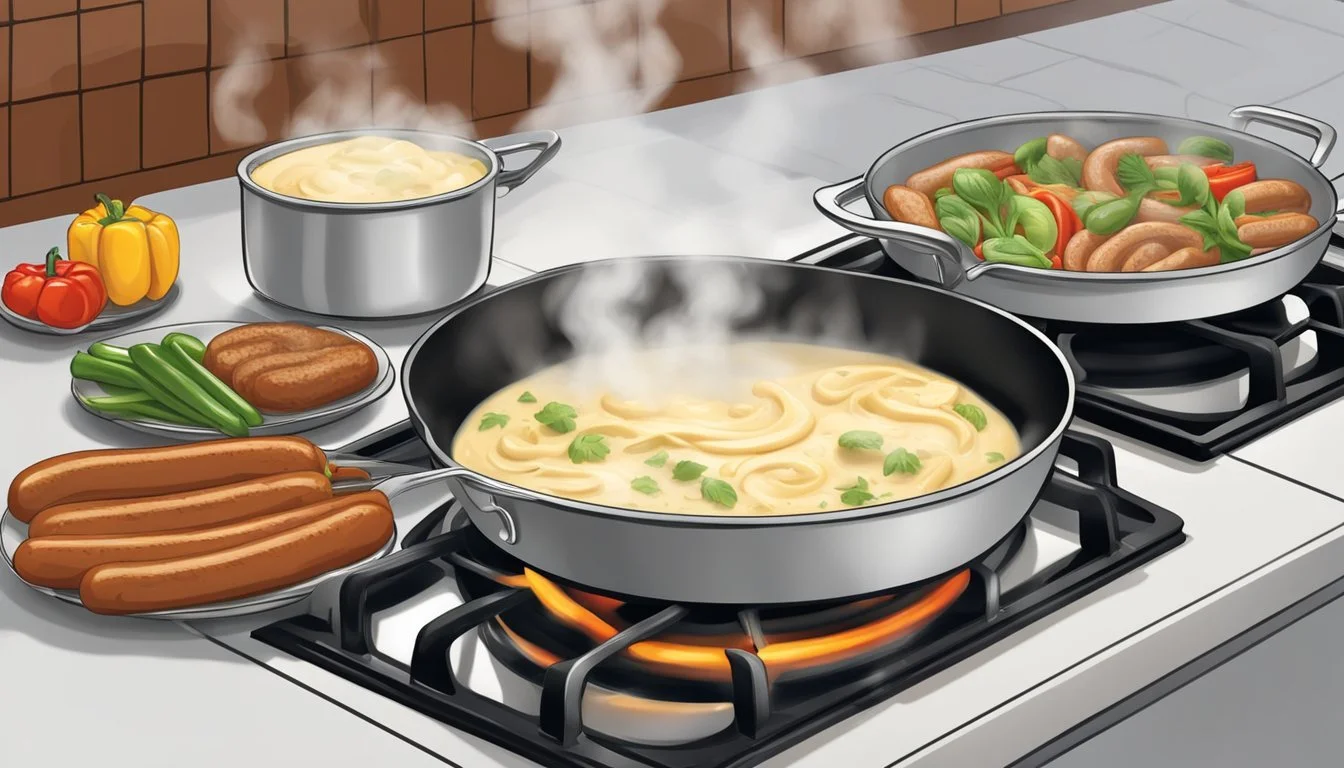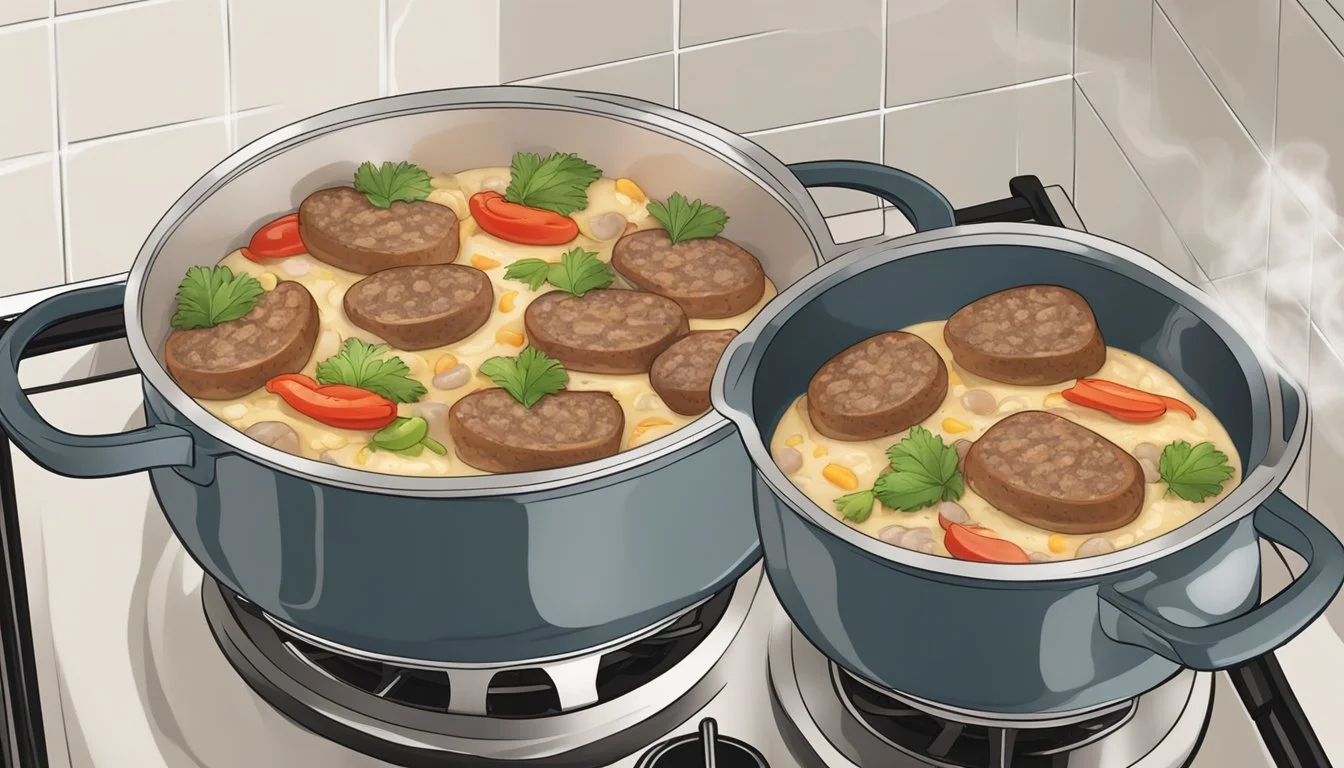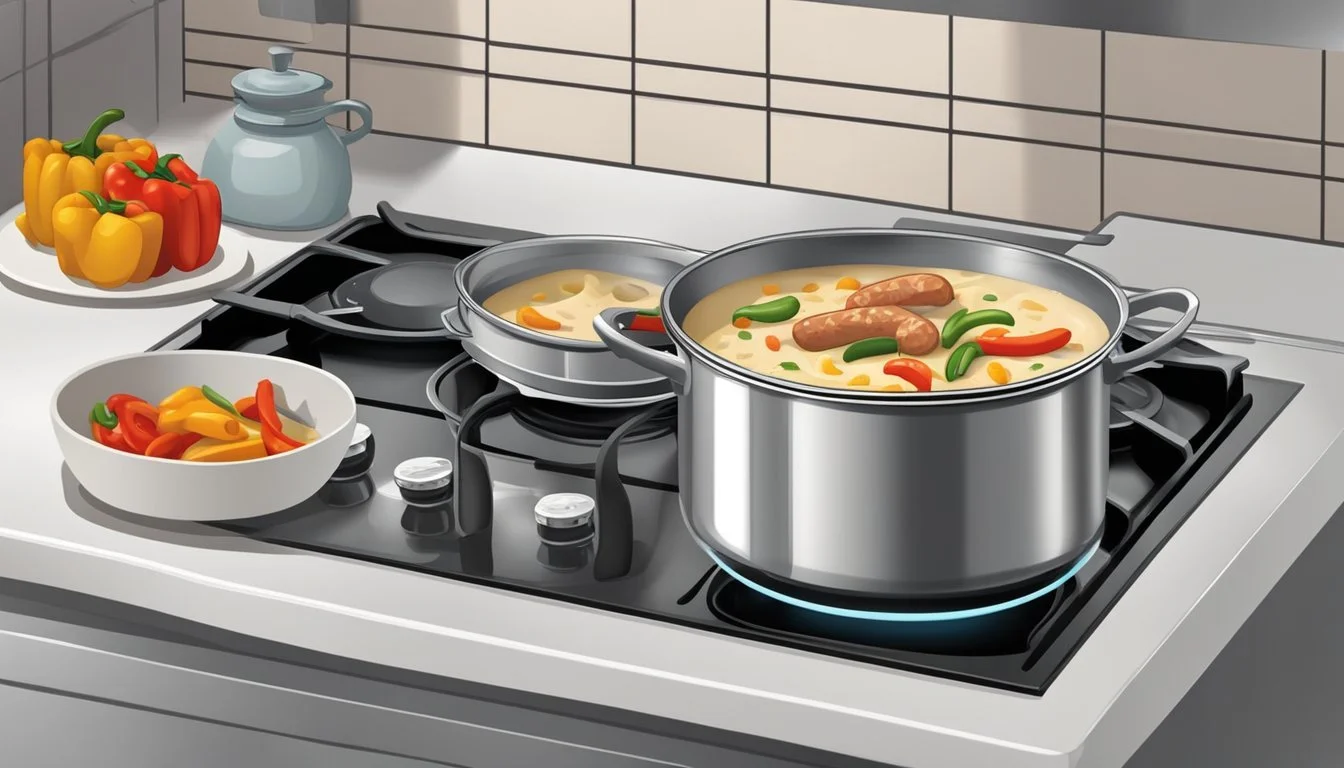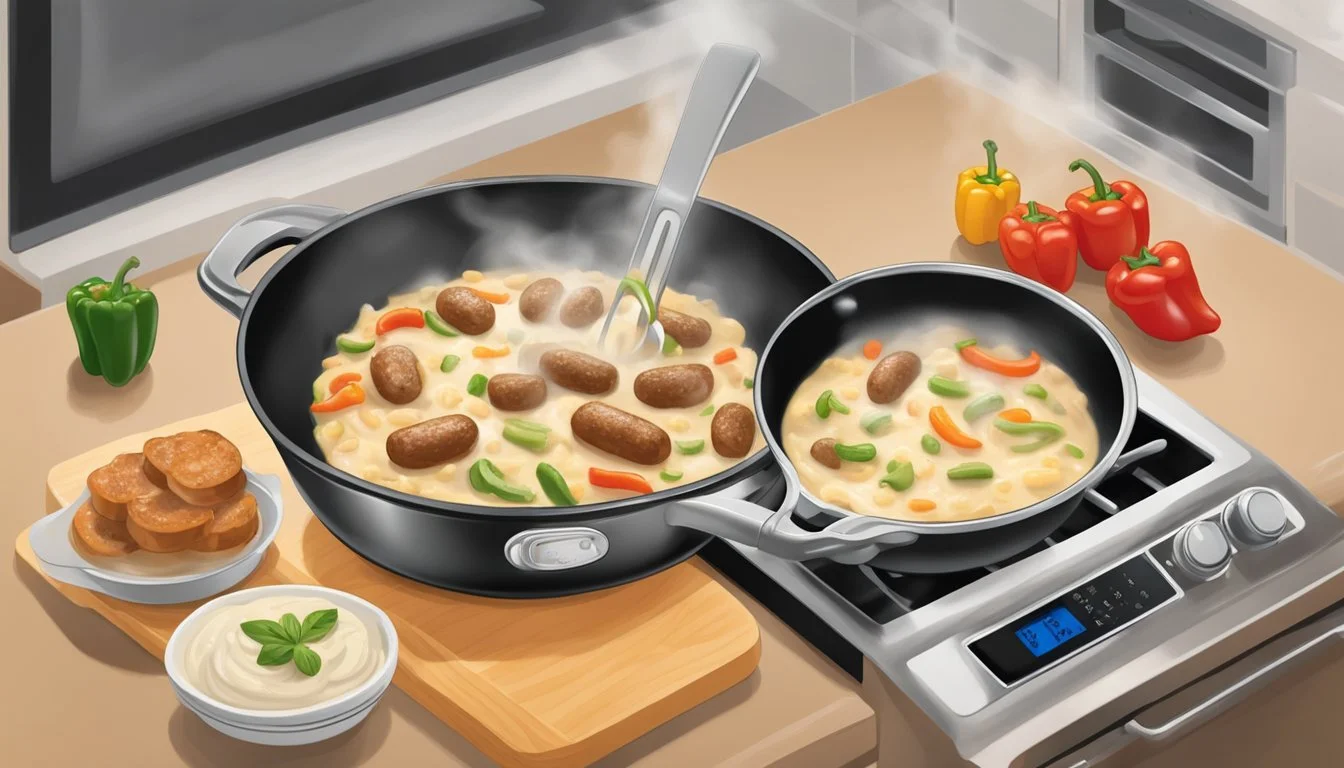How to Reheat Alfredo Sausage and Peppers
Expert Tips for Perfect Results
Reheating Alfredo Sausage and Peppers can be straightforward and highly effective in retaining the dish's delicious flavors and textures. This dish, known for its creamy Alfredo sauce combined with the hearty taste of sausages and the freshness of bell peppers, can be just as enjoyable the second time around if reheated correctly. Preheating your oven to 350°F (175°C) and covering the dish with aluminum foil to lock in moisture are key steps to ensuring the meal stays succulent and flavorful.
One effective method involves placing the sausage and peppers in an oven-safe dish, covering it tightly to prevent moisture loss, and baking for about 15-20 minutes. This approach helps to evenly reheat the dish without drying it out. For those who prefer a quicker option, using a stovetop can also be a good alternative; simply cover the frying pan with a thin layer of water, heat over medium-low, and stir occasionally.
It is crucial to monitor the internal temperature of the sausages, aiming for around 160°F to ensure they are thoroughly heated. Reheating without compromise on the quality means taking these careful steps, making sure each bite is as delightful as it was when freshly cooked.
Understanding Reheating Fundamentals
When reheating Alfredo sausage and peppers, paying close attention to temperature control, moisture retention, and avoiding overheating ensures the meal's flavor and texture remain intact.
Importance of Temperature Control
Temperature control is vital to achieve even heating. Reheating at a low temperature, around 140-160°F (60-71°C), helps maintain the consistency of the Alfredo sauce. Using a food thermometer can verify the dish reaches a safe but not excessively high temperature. Avoid overheating to prevent burning and dry spots.
Applying gentle heating methods such as using an oven or a stove can help control the temperature better. High heat can quickly ruin the texture, especially in creamy sauces, leading to an unsatisfactory result.
Moisture Retention Techniques
Maintaining moisture is critical to prevent the Alfredo sauce from drying out. Covering the dish with a lid or foil traps steam, which helps preserve moisture. Adding a small amount of cream, milk, or water can also keep the sauce creamy and prevent it from breaking.
Stirring the sauce occasionally during reheating helps in even distribution of heat and moisture. Keeping the heating consistent and slow ensures the sausage and peppers retain their intended flavors and textures.
Avoidance of Overheating
Overheating can lead to a loss of flavor and an unpleasant texture. It's essential to reheat slowly and check frequently. Avoid using high heat settings, especially in microwaves, as they can cause the Alfredo sauce to separate and the sausage to dry out.
Using lower heat settings and taking the time to reheat the dish carefully will avoid burning and maintain the quality of the Alfredo sauce and the tenderness of the sausage and peppers.
Preparatory Steps Before Reheating
Proper preparation is essential for reheating Alfredo sausage and peppers to ensure they retain their flavor and quality. Key steps include correctly storing leftovers and allowing the food to come to room temperature.
Storing Leftovers Correctly
Store any leftover Alfredo sausage and peppers in an airtight container. This helps maintain freshness and prevents contamination. Place the container in the refrigerator within two hours of cooking to minimize the risk of bacterial growth.
Label the container with the date to keep track of when it was stored. Use leftovers within three to four days to ensure food safety. If storing for a longer period, consider freezing to maintain quality.
Portion the food into smaller quantities if possible. This allows for more even reheating and reduces the risk of parts remaining cold while others get overcooked.
Bringing Food to Room Temperature
Remove the container from the refrigerator and let it sit on the counter for about 20-30 minutes. This helps equalize the temperature and ensures more even reheating.
If your kitchen is especially cold, consider letting the food rest in a warmer section or near a heat source, but not directly on it.
Avoid reheating food that is still cold from the fridge as this can lead to uneven heating, especially with dishes that have meats like sausages and peppers, and creamy sauces like Alfredo.
Resting the food at room temperature also helps preserve the texture and flavor, ensuring a more enjoyable meal when reheated.
Stovetop Reheating Method
When reheating Alfredo sausage and peppers using the stovetop method, it's essential to use proper techniques for even heat distribution and careful management of heat levels to maintain the dish's creamy texture without it sticking. Follow these detailed steps to achieve the best results.
Using Skillets for Even Heat Distribution
A skillet is ideal for reheating Alfredo sausage and peppers on the stovetop due to its ability to distribute heat evenly.
Begin by preheating the skillet over medium-low heat. Adding a small amount of water, milk, or cream to the skillet helps keep the Alfredo sauce creamy and prevents it from drying out.
Place the Alfredo sausage and peppers in the skillet, stirring frequently to ensure that the sauce re-emulsifies and the dish heats uniformly. Using a skillet with a lid can trap moisture and heat, reducing the risk of the sauce separating or the sausages drying out.
Regular stirring is crucial to prevent sticking and maintain a smooth consistency. The even heat distribution of a skillet ensures that the dish heats evenly, resulting in a delicious, creamy meal.
Managing Heat Levels on the Stove
Effective management of heat levels is critical to reheating Alfredo sausage and peppers properly on the stovetop. Starting with medium-low heat helps prevent the sauce from burning or separating, which is key to maintaining a creamy texture.
Gradually increasing the heat, if required, aids in controlling the reheating process without overheating the dish. Consistent stirring ensures even heating and prevents the sausage and peppers from sticking to the skillet.
Never use high heat as it can cause the sauce to scorch and the sausages to overcook quickly. Careful monitoring and adjusting the heat as needed will help preserve the quality and flavor of Alfredo sausage and peppers, ensuring a satisfying reheated dish.
Oven Reheating Technique
To effectively reheat alfredo sausage and peppers in the oven, it’s essential to prepare the oven correctly, control moisture, and set the right temperature for even heating.
Preparing the Oven
Begin by preheating the oven to 350°F (175°C). This temperature is ideal for ensuring the dish heats evenly without drying out.
Slicing the sausages into bite-sized pieces allows for quicker and more uniform reheating. Arrange the sausages and peppers in an even layer on a baking sheet or in an oven-safe dish to promote thorough heating. Using an oven-safe dish ensures that the ingredients maintain their flavors and textures.
Covering for Moisture Control
Cover the dish with aluminum foil or an oven-safe lid. This step is crucial to prevent moisture loss and maintain the dish’s tenderness.
Be sure to tightly seal the foil around the dish’s edges to trap steam inside. If you prefer a slightly crisper texture, you can partially cover the dish, leaving a small gap for steam to escape.
Setting the Correct Temperatures
Bake the alfredo sausage and peppers at 350°F (175°C) for about 15-20 minutes. Check the internal temperature of the sausages using a meat thermometer to ensure they reach at least 160°F (71°C).
If the dish isn’t heated through, continue baking in 5-minute intervals. For even heating, consider stirring the contents halfway through the reheating process. The moderate oven temperature allows for a consistent heat that warms both the alfredo sauce and the sausage and peppers evenly.
Microwave Reheating Tips
For reheating Alfredo sausage and peppers, using a microwave can be quick and efficient when done properly. Key points include adjusting power settings, stirring regularly, and preventing dryness to maintain a smooth texture.
Adjusting Power Settings
When using a microwave, it's important to adjust the power settings to avoid overcooking. Use medium power to reheat Alfredo sausage and peppers, as high heat can make the dish dry and mushy. Start with 1-2 minutes at medium power and check the temperature. If needed, continue heating in 30-second intervals. This method helps to ensure the dish heats evenly without losing its flavor and smooth texture.
The Importance of Stirring
Stirring the Alfredo sausage and peppers during reheating distributes the heat evenly. After the initial heating period, stir the contents thoroughly before placing them back in the microwave. Repeat this process every 30 seconds until the desired temperature is reached. Stirring helps to prevent cold spots and maintain the overall consistency of the dish, ensuring a more enjoyable eating experience.
Preventing Dryness and Uneven Temperatures
To prevent dryness, cover the Alfredo sausage and peppers with a damp paper towel before reheating. This traps steam and keeps the dish moist. Additionally, pricking the sausages with a fork can help heat penetrate better. Monitor closely, flipping and stirring as necessary to ensure the meal heats uniformly. Maintaining moisture and even temperatures are crucial for preserving the dish's quality.
Alternative Techniques and Tips
When reheating Alfredo sausage and peppers, maintaining the creamy texture and preventing separation are key. The following techniques can help ensure the best results, utilizing specific methods and ingredients.
Double Boiler Reheating
Using a double boiler is an effective way to reheat Alfredo sauce without it separating. By gently heating the sauce, the risk of breaking it is minimized.
Place a pot of water on the stove and bring it to a simmer. In a heat-resistant bowl, add the Alfredo sauce and place it over the simmering water. Stir constantly to promote even heating. This method ensures the sauce heats uniformly, preserving the desired creamy consistency.
Adding Liquidity to Dishes
Another way to maintain the sauce's texture is by adding moisture during reheating. This can be done with milk, cream, or even reserved pasta water.
Begin by adding a small amount of liquid to the sauce. Gradually incorporate more as needed until the desired consistency is reached. Best practices include stirring continuously and reheating over low to medium heat to prevent curdling or burning. This helps to integrate moisture back into the sauce, ensuring a smooth and rich texture.
The Role of Cream and Milk
Cream and milk play a crucial role in reheating Alfredo sauce, helping to revive its creamy nature. Heavy cream or whole milk can be used effectively.
When reheating, add a splash of heavy cream or milk to the sauce and stir. Reheat over gentle heat, avoiding high temperatures that can cause separation. These dairy components emulsify with the sauce, restoring its rich texture. Cooking times will vary, but keeping the heat low and stirring frequently will yield the best results.
By following these techniques, reheating Alfredo sausage and peppers can be done efficiently without compromising the sauce’s quality.
Maintaining Quality and Safety
Proper reheating ensures both food safety and the preservation of texture and flavors. It's essential to follow specific steps to prevent food contamination and check for any signs of spoilage before consuming leftovers.
Preventing Food Contamination
To reduce the risk of foodborne illness, start with clean utensils and surfaces. Always wash hands before handling food. Preheat the oven or stovetop to the correct temperature to ensure even heating. For Alfredo sausage and peppers, heating to an internal temperature of 165°F (74°C) is crucial for killing any harmful bacteria.
Using a food thermometer is the best way to verify the internal temperature. Additionally, covering the dish with aluminum foil or a lid helps retain moisture and prevents cross-contamination from other foods. Stirring or rotating the dish halfway through reheating ensures uniform warmth, preserving the flavors of the sausage and the creamy Alfredo sauce.
Checking for Spoilage Signs
Before reheating, inspect the Alfredo sausage and peppers for spoilage signs. Look for any visible mold on the cheese or sausages. Smell the dish; it should have a fresh, appetizing aroma. Any sour or unpleasant odors may indicate it has spoiled.
Check the texture of the peppers and sausages. They should be firm and not slimy or sticky. If there’s any doubt, it’s safer to discard the food. Food safety is paramount, and consuming spoiled leftovers can lead to severe health issues. Consistently verifying these spoilage signs ensures you enjoy a safe and delicious reheated meal.
Enhancing the Dish Post-Reheating
After reheating Alfredo sausage and peppers, enhancing the dish with fresh ingredients and pairing it with complementary sides can elevate the overall dining experience. These simple additions can enhance the texture and flavors of your meal, making it more enjoyable.
Garnishing with Fresh Ingredients
Adding fresh herbs such as basil, parsley, or thyme can provide a burst of freshness that complements the richness of Alfredo sauce. Fresh basil's sweet and peppery flavor pairs well with the creamy sauce, while parsley adds a mild bitterness that can balance the dish.
Slice sausages thinly before reheating to ensure even warming and mix them into the sauce thoroughly. This helps integrate the protein more completely, enhancing the texture and flavors. Cherry tomatoes, sliced in halves, can add a juicy sweetness.
Consider sprinkling some grated Parmesan cheese on top for extra umami and richness. A dash of crushed red pepper flakes can introduce a subtle heat that contrasts nicely with the creaminess. Finishing touches like these can transform reheated leftovers into a restaurant-quality meal.
Pairing with Complementary Sides
Pairing Alfredo sausage and peppers with the right sides can balance the heaviness of the dish and add variety. Garlic bread is a classic choice; its crispy texture and buttery flavor can complement the creamy sauce.
Steamed or roasted vegetables such as broccoli, asparagus, or spinach provide a healthy and textural contrast. Their earthy flavors and slight crunch can harmonize with the smooth, rich Alfredo sauce.
A simple green salad with a light vinaigrette dressing can offer a refreshing counterpoint. Use mixed greens, cherry tomatoes, and cucumbers to add varying textures and colors. A citrus-based dressing can cut through the richness of the Alfredo sauce, balancing the meal.
Lastly, serving the dish with a side of whole grain pasta or quinoa can add nutritional value and enhance the meal's overall texture and flavors. The grains' nutty taste pairs well with creamy sauces and provides a wholesome addition for a complete meal.
Conclusion
To achieve evenly reheated Alfredo sausage and peppers, focus on maintaining an even heat distribution.
This ensures that each component is warmed without drying out or overcooking any ingredients.
Using an oven, cover the dish with foil to trap moisture and heat the sausage and peppers thoroughly.
For the stovetop, using a low heat setting and frequent stirring helps in maintaining an even temperature throughout the dish.
Keeping the creamy texture of Alfredo sauce intact is crucial.
When reheating, do so gently to prevent the sauce from splitting. Low and slow methods like stovetop and oven reheating are highly effective. Adding a small amount of milk or cream can help revive the richness of the Alfredo sauce.
Additionally, methods such as using an air fryer can retain the texture and flavors of the dish effectively.
Remember to avoid high-heat methods that can cause loss of moisture and texture. Adjusting times and temperatures as needed based on your equipment is key.
Experimenting with different reheating methods can help find what works best for your specific preferences.










